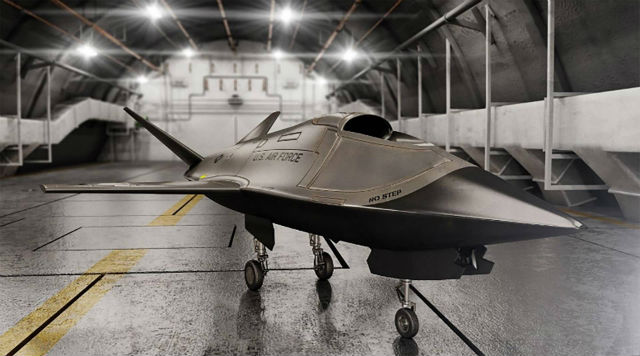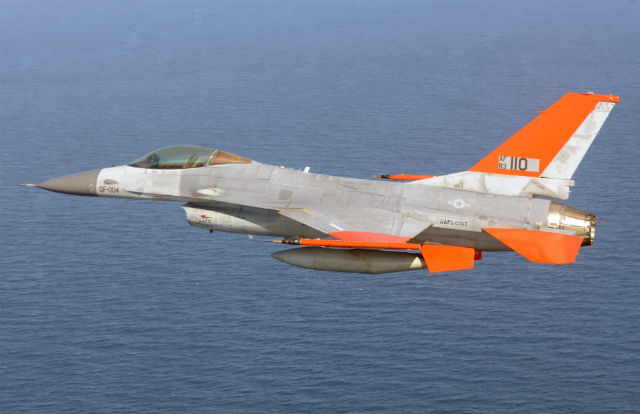Stretched thin by operations across the globe and new threats from adversaries such as China and Russia, the US Air Force is experimenting with an idea to fill the gaps in America’s fighter squadrons. The so-called Loyal Wingman concept – to deploy semi-autonomous unmanned air vehicles – may radically change the way the service fights.
How the USAF moves forward will in part be informed by test flights this autumn of an experimental aircraft designed to demonstrate the new concept, the XQ-58A Valkyrie. The UAV’s manufacturer, target drone maker Kratos Defense & Security Solutions, boasts that it can build the aircraft for $3 million or less for up to the first 99 units, and $2 million or less for purchases of 100 units or greater.

US Air Force
That low price makes the aircraft, in Air Force Research Laboratory (AFRL) lingo, “attritable” – that is, inexpensive enough to risk losing in dangerous missions, although not necessarily disposable. Attritable UAVs could be used in situations where the military would not want to risk a pilot’s life or expensive aircraft.
“We don’t send manned aircraft in really high-risk areas anymore. We send a cruise missile,” says Thomas Hammes, senior research fellow with the National Defense University. “We can start doing that with Loyal Wingman.”
A low price point also means these UAVs could be fielded in greater numbers than expensive fifth-generation aircraft. At its lowest, Lot 9 price, a Lockheed Martin F-35A Lightning II stealth fighter costs $94.3 million – money that could pay for maybe three dozen Loyal Wingmen.
And because the XQ-58A Valkyrie could possibly be launched vertically using rocket boosters and recovered using parachutes – a legacy of Kratos’s work in the aerial target industry – such a UAV could presumably be stationed nearly anywhere, with no need to rely on an expensive and vulnerable airfield or aircraft carrier.
Such flexibility has sparked the imagination of some military analysts, who see a host of possibilities for the concept.
“If you can do vertical take-off you can scatter the aircraft all over the country,” says Hammes. “You could launch them from a merchant ship in a container, just like cruise missiles are launched from containers. This is a real cost saving, because a merchant ship has a crew of 12, while an aircraft carrier has a crew of 4,000.”
Kratos’s XQ-58A is not the only candidate for the Loyal Wingman role. In 2015 and 2017, Lockheed also demonstrated for the AFRL, as part of its Have Raider programme, an autonomous QF-16 flying in formation with a lead aircraft and conducting a ground-attack mission before automatically rejoining formation.

US Air Force
If the USAF were to adopt low-cost unmanned Loyal Wingmen in significant numbers – either the QF-16 or XQ-58A – it would reverse, at least in a small way, a decades-long shrinking of the US fighter and attack aircraft fleet, a trend driven by the service’s preference for quality over quantity. This inventory peaked at 9,355 aircraft in 1956, after the Korean War, and fell over the years to 1,970 in 2016, according to an analysis by the Mitchell Institute think tank.
Loyal Wingmen will not be able to replace manned aircraft capabilities one for one initially, but instead should enhance the existing fifth-generation fighter fleet, says Larry Stutzriem, a retired USAF major general who is now the Mitchell Institute’s director of research.
“Ultimately, our fifth-generation assets are the tip of the spear,” he says, noting that a low-cost UAV cannot replace the capabilities of advanced stealth aircraft such as the F-35 or Northrop Grumman B-21. “The Loyal Wingman is a very efficient way of adding capacity. It’s very cost effective.”
Kratos has been developing the XQ-58A since 2016, when it received a $40.8 million cost-share contract from the AFRL for its attritable strike demonstrator programme.
Under the arrangement, Kratos received $7.3 million in government funding, while it invested up to $33.5 million of its own capital. This allowed it to keep assets including the aircraft, intellectual property, software, data, and platform and system rights.
LOW COST
The company believes it could keep costs low on the production version of XQ-58A with the help of commercial-off-the-shelf materials, sub-systems, manufacturing processes and open mission system architecture concepts. Also, by ditching the pilot, the manufacturer does not have to incorporate life support systems.
“It costs a lot of money to move protoplasm around in the sky and keep it alive,” says Hammes.
The Department of Defense’s move toward low-cost attritable strike UAVs is a change from efforts over the past 15 years, which were focused on developing expensive, stealthy and sophisticated deep-strike UAVs such as the Boeing X-45 and Northrop X-47B.
It is not an either-or decision, however. Alfredo Ramirez, Northrop’s vice-president of engineering for its autonomous system division and a veteran of the X-47B programme, says: “It all depends on what the mission is. You can use low-cost attritable systems or you can use complex systems that are meant to come back.”
But despite its cheap price, Kratos believes the XQ-58A – 9.14m (30ft) long and with an 8.23m wingspan – will retain significant performance, including a 272kg (600lb) payload and an internal weapons bay sized to carry and deliver at least two Boeing GBU-39 small diameter bombs. The aircraft will have the capability to reach Mach 0.9 in dash and is characterised as having “maximum-g-load limits”, it says.
The AFRL cautions that renderings of the aircraft released last year are artist’s concepts that may not accurately reflect the real vehicle. However, those images – and statements from Kratos about “vehicle shape, elimination of gaps and mismatches, and aero-structural inlet integration” – seem to indicate that the UAV would have a stealthy figure. Both Kratos and the AFRL decline to comment.
Kratos envisions a reconfigurable XQ-58A for adaptation to varied missions such as nap-of-the-earth flight, high-altitude cruising, offensive or defensive counter-air manoeuvres and the suppression or destruction of enemy air defences.
MULTIROLE
Initially, industry observers suggest the Loyal Wingman may be best suited to play a role as a redundant communications node, or intelligence, surveillance and reconnaissance platform – gathering information about air and ground threats, then fusing and relaying that information back to an F-35 pilot.
“It helps from a big picture perspective, for survivability, largely from a situational awareness perspective, when every node in the distributive system is a learner, a sharer, that is able to communicate,” says Justin Taylor, mission systems roadmaps director at Lockheed Martin’s Skunk Works, who worked on the company’s Have Raider programme.
“We think it’s going to help us offload work from a manned platform, allowing us to have a more robust architecture. If nodes in a distributed architecture or communication line go down during a mission, we need flexibility.”
Such UAVs might also be useful as electronic warfare platforms, blinding an adversary’s anti-aircraft defences and freeing up assets such as F-35s to stealthily sneak beyond enemy lines and launch precision ground strikes, he adds.
Teaming manned aircraft with semi-autonomous UAVs is an increasingly prevalent tactic across US military services, with examples including the US Army’s Boeing AH-64 Apache helicopter flying in concert with the General Atomics Aeronautical Systems MQ-1C Gray Eagle, as well as the US Navy’s Sikorsky SH-60 Seahawk teaming with a Northrop MQ-8 Fire Scout.
It is possible that a USAF fighter pilot could be teamed with two to four Loyal Wingmen, says Stutzriem.
“We would see a period where you are managing through a flight leader, maybe an F-35 piloted aircraft,” he says.
“We want eventually for that Loyal Wingman to sense what’s around it and make decisions autonomously.” Autonomy could allow a UAV to plan its own navigation to avoid thunderstorms or to suppress enemy defences, he says.
Many view the ultimate goal of autonomy to be the co-ordination of large numbers of low-cost UAVs in swarms, a tactic which could overwhelm an adversary’s air defences. However, before approaching that point, the USAF have to decide on the aircraft.
Both Hammes and Stutzriem advocate using converted F-16s for the first Loyal Wingman, as a more familiar and cheaper option. Lockheed declines to comment on the conversion costs.
“You don’t want to jump completely with a new technology without knowing what you’re doing,” says Hammes. “You don’t want to abandon the old system completely until you’ve tested the new system.”
For its part, the AFRL appears smitten with its latest project. “Potentially it may make more sense to build on a programme that we’ve been advancing for a number of years, and that’s the low-cost attritable aircraft,” said Maj Gen William Cooley, commander of the AFRL in July. “The XQ-58A is the first step.”
Source: Flight International


























